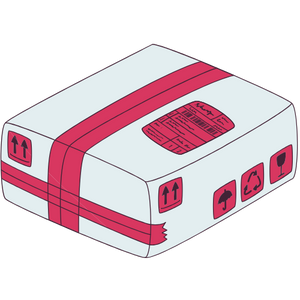What causes a heavy flow?
Menstrual flow changes throughout the menstrual cycle, but also over the course of a woman's life. Birth control, fatigue, pregnancy, illness, emotional stress, or simply age can all impact the menstrual cycle and flow.
Menstrual flow is generally divided into three distinct categories:
- light flow,
- medium or normal flow,
- heavy or very heavy flow.
What causes a heavy flow or very heavy flow? What could be the reasons for heavy periods? To address any concerns, Louloucup is taking a closer look at the reasons behind a heavy or very heavy menstrual flow.
How to tell the difference between menorrhagia and heavy flow
It can sometimes be hard to know if your period is naturally heavy or if it’s a case of menorrhagia. Menorrhagia means abnormally heavy and prolonged periods.
🩸 What’s the difference between menorrhagia, metrorrhagia, and spotting?
Menorrhagia refers to abnormally heavy periods. Metrorrhagia, on the other hand, is bleeding that occurs outside of your period (outside your cycle, before puberty, or during menopause). However, these two conditions can also occur together, which is called menometrorrhagia.
Are you experiencing irregular periods? Are your cycles unpredictable or disrupted? To learn more, check out our article:
On the other hand, spotting refers to small amounts of bleeding (just a few drops) outside of your period. These little surprises can show up in your underwear. For more information, check out our article:
Now let’s look at how you can identify your menstrual flow type.
How can you tell if your period is too heavy?
Several ways to find out if you have a heavy menstrual flow. Options include the Higham score, observation, or measuring with a menstrual cup.
You can also read our article to help you: How to know your menstrual flow?
🩸 How do you use the Higham score method to determine your flow?
The Higham score is a tool used to measure the amount of blood lost during your period. It’s a chart that uses a points system based on the blood loss observed during a cycle.
If you’re interested in this tool, you can download it here.
The Liv invisible heavy flow period underwear by Louloucup
🩸 Assessing your flow visually
To help identify your flow type, you can compare the amount to the equivalent in period protection products.
|
Quantity |
Equivalent |
Flow type |
|
30 ml or less |
1 tampon a day or just a few drops on a pad |
Light flow |
|
between 30 ml and 50 ml |
2 to 3 tampons per day or 1 pad every 3 hours. |
Medium flow |
|
between 50 ml and 70 ml |
4 to 5 tampons per day or 2 pads every 3 hours |
Heavy flow |
|
over 70 ml |
1 pad every 2 hours or more |
Hemorrhagic flow |
🩸 Measuring your menstrual flow with a menstrual cup
Another effective way to gauge your flow is to use a menstrual cup. Since the blood is collected rather than absorbed, it’s easier to measure how much you lose.
A great way to learn more about your body, your menstrual cycle, and how your flow changes throughout your cycles.
What causes a heavy flow?
There are many possible causes for heavy periods. Here are a few things to consider to get you started. It’s always important to get the opinion of your doctor or gynecologist as well.
🩸 Hormonal fluctuations can cause a heavy flow.
A hormonal fluctuation can cause a heavy flow. In particular, excessive estrogen production increases the size of the endometrium and therefore the amount of bleeding. If your heavy periods are too limiting or disabling, don’t hesitate to talk to a healthcare professional (doctor, gynecologist, or midwife). There are solutions to balance your hormones.
🩸 Benign tumors can cause heavy periods
- A fibroid is a mass that forms in the muscular tissue of the uterus. Between 50 and 80% of women will have a fibroid at least once in their lives. But only 1 in 4 women will have symptoms that require treatment. Fibroids usually go unnoticed unless they cause heavy periods.
- Polyps form in the uterus and are usually only discovered around age forty or during an infertility evaluation. They are mostly benign and disappear on their own one out of three times.
This is the main cause of abnormal bleeding in women over 40.
However, for women over 45, a biopsy is performed to ensure the polyp is benign.
🩸 Adenomyosis causes heavy flow
Adenomyosis is a condition affecting the junction between the endometrium (the lining of the uterus) and the myometrium (the muscle of the uterine wall). This abnormality causes endometrial cells to infiltrate the myometrium.
To put it simply, this is called internal uterine endometriosis.
50% of adenomyosis cases involve heavy menstrual bleeding.
🩸 Clotting disorders can cause heavy periods
Clotting disorders are caused by low levels of proteins needed for normal blood clotting.
Most often, it’s Von Willebrand disease or hemophilia.
Because these bleeding disorders are hereditary, women in the same family may not realize that heavy periods aren’t normal. That’s why you shouldn’t hesitate to break the period taboo and talk to your gynecologist—solutions do exist.
🩸 Wearing an IUD can cause heavy periods
Wearing a IUD or copper coil can cause heavier periods. It’s generally not recommended for women who already have heavy or painful periods. If your periods are particularly heavy or even hemorrhagic during the first cycles after getting an IUD, they usually calm down over time, though they tend to remain heavier than average.
What should you do if you have a heavy period?
🩸 What should you do when your Higham score is over 100?
If your Higham score is over 100, you should consult your gynecologist, who can determine the best course of action.
🩸 When should you worry about heavy periods?
Unusual fatigue and hair loss should be a warning sign of a possible iron deficiency caused by heavy blood loss.
Generally speaking, if your daily life is being affected or dictated by your period, it’s time to talk to a healthcare professional.
Managing a heavy flow
With a menstrual cup or period underwear, managing a naturally heavy or very heavy flow is easy! Both types of reusable period protection are perfectly suited to absorb even the heaviest flows.
Opt for period panties or high-waisted menstrual underwear with full coverage and an absorbent layer that extends high in the front and back. Say goodbye to dampness and odors—made in Europe from organic cotton, try Louloucup’s menstrual underwear.
How do you manage heavy flow with period underwear? Are period panties for heavy, very heavy, or even hemorrhagic flow a good idea?
The menstrual cup is also excellent in this situation. This bell-shaped internal protection collects blood optimally. Made from medical-grade silicone, ultra-soft and easy to insert, the Loulou cup is perfect!
Check out the different Loulou menstrual cups as well as the range of Louloucup heavy and very heavy flow period panties, available now! Free delivery in France and Europe, shipped within 48 hours!




























